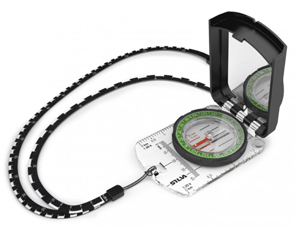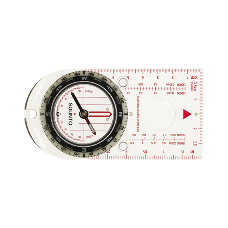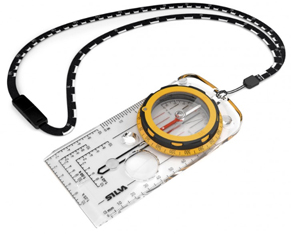Navigation Tutorial
Lesson 2 - Compass Skills
All content copyright © Ashley Burke 2008. Not to be copied, duplicated or used for any purpose without permission.
Navigation Tutorial Lesson 2 - Compass Skills
All content copyright © Ashley Burke 2008. Not to be copied, duplicated or used for any purpose without permission. |
Navigation course by Ashley Burke
Figure 7.1 shows a compass of the type that is normally used in bush navigation.

Fig 7.1: Parts of a compass.
Take a look at Figure 7.1 in which the parts of a compass are labelled. Here is a description for each of the parts of the compass:
| Floating magnetic needle | When the compass is held level and away from metal objects or magnetic fields, then the red end of this needle points to magnetic north. |
| Movable dial | This dial can be rotated. You use this to set your bearing. You will learn how to use this later. |
| Orienting arrow | This is fixed to the dial so it rotates with the dial when you move it. |
| Directional arrow | Use this to follow your bearing. See later. |
| Neck cord | Hang your compass around your neck so you don't lose it. |
| Declination Scale (not shown) | Some compasses (eg: the Suunto M-3) have an adjustable declination scale on the inside of the movable dial. This allows you to set the grid to magnetic angle, eliminating the need for you to adjust for it manually. See Sections 8 and 9 and Appendix A. |
Compasses come in a wide variety of shapes and sizes and they can also vary quite widely in price. When choosing a compass to buy, here are some general guidelines:
Here is a review of a few widely available compasses.
| Manufacturer | Model | RRP | My Rating | Comments | |
|
Silva | Ranger | $A62 | The Silva Ranger and the Silva Ranger S are my two favourites. The Silva Ranger is the compass I use on most trips, though on my navigation courses I choose the version with a mirror (see "Silva Ranger S" below). You'll see the advantages of the mirror if you join a navigation training weekend. The Silva Ranger is a great compass, it is small, light, has all the features you need and the lines on the inside of the compass dial make it easy to set bearings from the map. Choose a model that is weighted for your hemisphere. There are southern hemisphere, northern hemisphere and equatorial models. |
|
 |
Silva | Ranger S | $A90 | This is the other compass in the Silva Ranger series and features a mirror for sighting. If you join one of my navigation training weekends, you will see that this is the compass I take on those navigation weekends. The mirror allows for more accurate sightings, as you will see if you join a navigation weekend. Although the mirror adds weight and bulk to the compass, this latest Silva Ranger S is nonetheless light and compact and the unit fits comfortably in your shirt pocket. The mirror flips up and down easily. Like the Silva Ranger, this compass is weighted for your hemisphere and may not work well in other parts of the world. |
|
 |
Suunto | M-3 G | $A100 | A quality compass from Suunto. It has many advantages but also some disadvantages. Pros
Cons
|
|
 |
Suunto | MC-2 G | $A140 | All the features of the Suunto M-3 G plus a mirror for sighting. As mentioned, the mirror enables more accurate sightings. Like the M-3 it has a declination adjustment, a clinometer, and will work globally. I am pleased that the 1:24000 measuring scale is absent on this model, but the 1:25000 and 1:50000 measuring scales are not as easy to use as the ones on the Silva. | |
 |
Kathmandu | V2 | $A20 | A popular compass because it's cheaper. It lacks an orienting arrow and instead just has fluorescent marks where the orienting arrow should be. Not as high quality construction as the Silva and Suunto brands and the needle is less settled. This is your budget option. | |
 |
Suunto | A-30 | $A60 | This is a good compass for its price. The needle is more jittery (less stable when the compass is moved) than more expensive models. It comes in metric and non-metric variants. The one I reviewed was metric, meaning that the scales on the edges of the compass are suitable for measuring distances on a 1:25000 or a 1:50000 scale map. Choose a variant for your hemisphere. The compass I reviewed was weighted for the southern hemisphere and most likely does not work well in the northern hemisphere. The baseplate is uncluttered and whilst it lacks some features of high end compasses, it has all the necessary basics at an affordable price. Good choice for a basic all purpose compass. Like all Suunto models, I am disappointed that the Suunto logo has to be inside the compass dial. This space would be better left for the orienting lines only, as this is critical to accurate navigation. |
|
 |
Silva | Expedition | $A100 | The "Silva Expedition" is one of the more advanced and full-featured compasses in the Silva range. It is notably larger than the Silva Ranger, the baseplate being both longer and wider, which gives more "real estate" for ruling lines on your map and for incorporating other features. It does make the compass bulkier in your shirt pocket though. The compass has several additional features, not all of which are especially useful in most Australian conditions. Like most good compasses, it has a magnifiying glass and 1:25000 and 1:50000 measuring scales on the baseplate. It also has a 1:40000 measuring scale though maps at this scale are uncommon. It has a declination adjustment which allows you to set the grid to magnetic angle permanently in the compass, much like the Suunto M-3 global compass does. It also has a clinometer for measuring the steepness of a slope, though this is not especially useful. It comes with cards that allow you to determine the angle of a slope from the contours on a map. This is only really useful for assessing avalanche risk, so not applicable in the Blue Mountains or most of Australia. It has friction feet to stop the compass slipping on the map - this is very useful. And finally, it has a stencil in the baseplate for drawing on the map - not very useful at all. It is non-global, meaning you should pick a variant for your magnetic hemisphere. |
Compasses with a coloured or not perfectly transparent base plate, compasses with a very short base plate, or compasses in wildly different shapes and sizes to those above should be avoided unless you know otherwise.
Wear the compass around your neck using the neck cord. This will help ensure you don't lose it. Your compass is an essential tool and once out in a remote area you are sometimes completely dependent on it to prevent yourself from getting lost so don't lose it!
Ensure the neck cord is long enough so that the compass can be held out at arms length without taking it off.
When you are using the compass hold it horizontally so that the magnetic needle floats easily and does not rest on the surface of the dial that it is suspended in.
When reading the compass, ensure that it is held away from metal objects or possible sources of interfering magnetic fields such as other compasses, mobile phones, digital cameras, etc.
A bearing is simply a direction of travel. ie: whenever you are walking in a straight line, you are following a bearing. We normally quote bearings as an angle relative to magnetic north or grid north:
A magnetic bearing is the direction of travel as an angle relative to magnetic north.
A grid bearing is the direction of travel as an angle relative to grid north.
The angle that bearings are quoted in is a number between 0 and 360 degrees that refers to the angle to the east (clockwise) of north. So a magnetic bearing of 0° means you are heading towards magnetic north. A bearing of 90° is due east, 180° is due south, 270° is due west, and so on. It will always be a number between 0 and 360. 45° is north east and so on.
Navigation is about using your map and compass to determine the magnetic bearing that corresponds to the direction that you want to walk in. You set the compass so that it points along this bearing and then you use it to guide you in walking in that direction.
You will now learn how to do this by a series of steps. Click here to continue.
Web page created 12 Jul 2008, last updated 09 Sep 2024. All content copyright © Ashley Burke 2008. Not to be copied, duplicated or used for any purpose without permission. |